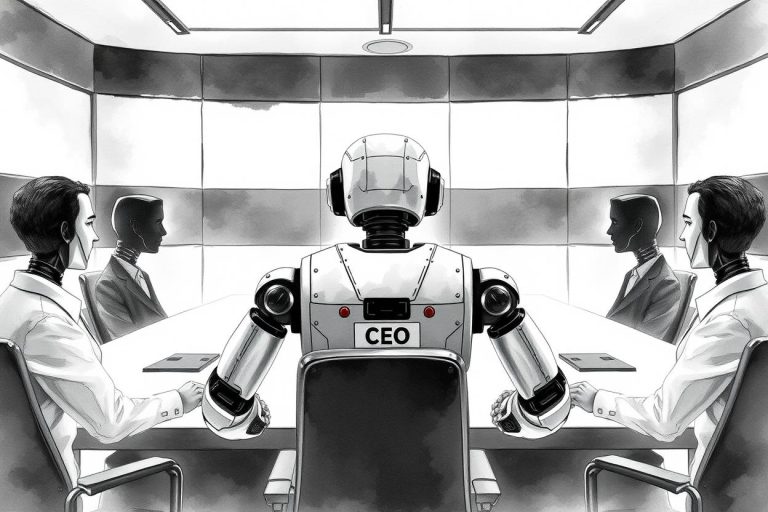Automation, AI and the Future of Work: Artificial Intelligence Statistics

As the rapid advancement of technology continues to reshape our world, the potential impact of artificial intelligence (AI), machine learning, and automation on the global workforce is a topic of ongoing debate. Let’s dig into some Artificial Intelligence statistics for a clear overview on how the world is being impacted by AI at scale and make sense of the numbers and percentages. As machines grow more sophisticated and capable, will human labor become obsolete, or will these technologies merely change the nature of work? This article aims to shed light on this complex issue by reviewing recent AI stats and trends in various sectors.
Sources: IDC, Mckinsey, Statista, Global Market Insights, KPMG, Forbes, Markets&Markets, PwC, Harvard Business Review, AIMultiple and more.
Job Displacement Due to Automation – AI Stats
By the early 2030s, automation is expected to put 30% of UK jobs at risk, which is lower than the US (38%) or Germany (35%), but higher than Japan (21%). The transportation and storage sector seems to face the highest risk (56%), followed by manufacturing (46%) and wholesale and retail (44%). On the other hand, sectors such as health and social work are expected to face lower risks [PwC].
While some jobs will undoubtedly be lost to automation, it is important to note that AI and machine learning will also create new job opportunities. Cognitive technologies, such as robots, AI, machine learning, and automation, will replace 16% of U.S. jobs but will also create 9% of new U.S. jobs by 2025. These new roles will include robot monitoring professionals, data scientists, automation specialists, and content curators. Additionally, 72% of business decision-makers believe AI will allow humans to concentrate on more meaningful work [PwC].
By 2030, however, automation could potentially replace as much as 30% of the world’s current human labor. Depending on various adoption scenarios, this could result in the displacement of between 400 and 800 million jobs, requiring as many as 375 million people to switch job categories entirely [McKinsey & Company]. It’s particularly threatening for workers with low levels of education, with 44% being at risk of technological unemployment by 2030 [PwC].

Challenges in AI Adoption and Statistics about artificial Intelligence
The integration and management of AI come with their fair share of challenges. A shortage of data science talent is the primary barrier to realizing value from big data technologies, as reported by 59% of respondents. The potential for bias and lack of transparency in AI adoption is a significant concern for 76% of CEOs. Moreover, 47% of executives find it hard to integrate cognitive projects with existing processes and systems [Harvard Business Review].
AI Statistics Across Industries
AI Stats in Healthcare
AI is being widely adopted in healthcare, with a significant positive impact. 91% of healthcare business leaders are confident in AI’s ability to monitor the spread of COVID-19 cases, and 94% believe it can assist with vaccine development [KPMG]. The sector has also made progress in AI utilization with 38% of providers using computers as diagnosis assistants [Gartner], and key clinical health AI applications potentially creating $150 billion in annual savings for the U.S. healthcare economy by 2026 [Accenture].
AI Stats in Manufacturing
93% of manufacturing business leaders say that AI is functional in their organizations. More than half of European manufacturers (51%) are implementing AI solutions, followed by Japan (30%) and the US (28%) [Capgemini]. AI is primarily implemented in maintenance (29%) and quality control (27%) among top manufacturers.
AI Stats in Banking
Confidence in AI’s ability to detect financial fraud has increased from 85% in 2020 to 93% in 2021 [KPMG]. With 80% of banks acknowledging the potential benefits of AI, it’s clear that the banking industry is eager to incorporate AI in their operations.
75% of banks with over $100 billion in assets are implementing AI strategies, compared to 46% at banks with less than $100 billion in assets [UBS Evidence Lab]. The utilization of conversational interfaces (chatbots) makes up around 13.5% of the AI vendor product offerings in banking, a surprising figure given that they make up nearly 39% of the AI use-cases across the top 100 banks in the US.
The success rate of bot interactions is expected to reach over 90% in 2022. The banking industry is projected to be one of the two industries that will spend the most on AI solutions by 2025. AI solutions are anticipated to add over $1 billion in value to the financial services industry by 2035 [Accenture].
AI Stats in Telecom
As the telecommunications sector evolves, 52% of telephone companies now employ chatbots. This trend is likely to continue, with 72% of businesses in the technology, media, and telecommunications industry expecting AI to have a significant impact on product offerings in the next five years [Forbes].
The AI market in telecommunications is projected to grow from $235.7 Million in 2016 to $2,497.8 Million by 2022, representing a Compound Annual Growth Rate (CAGR) of 46.8%.
AI Stats in Insurance
Insurance companies are increasingly seeing the value of investing in emerging technologies. Car, property, life, and health insurers are expected to increase their annual savings by more than four times by 2023, compared to 2019 [Juniper Research].
80% of insurance customers are looking for more personalized experiences, and insurers are expected to deploy AI solutions to meet this demand. However, adoption has been slower in this sector, with only 1.33% of insurance companies investing in AI compared to 32% in software and internet technologies [O’Reilly].
Driverless technology and other “radically safer” vehicles could shrink the auto insurance industry by 60% over the next 25 years [KPMG]. Despite some hesitancy, with 60% of consumers expressing concerns about purchasing coverage via chatbot, 68% of respondents in the insurance industry report using chatbots in some segment of their business [Accenture].
AI Stats in Sales and Marketing
AI is changing the game in sales and marketing. 30% of all B2B companies will employ AI to augment at least one of their primary sales processes. Companies using AI for sales have reported an increase in leads by over 50%, reduction in call time by 60-70%, and cost reductions of 40-60% [Harvard Business Review].
In marketing, 64% of B2B marketers consider AI valuable for their sales and marketing strategy. Despite this, 63% of B2B marketers are not using AI in their tech stack. While only 13% of B2B marketers are very confident with their knowledge of AI, 71% are interested in using AI for personalization.
AI Stats in Customer Service
AI is set to power 95% of all customer interactions by 2025, including live telephone and online conversations. By this time, customers will manage 85% of their relationship with the enterprise without interacting with a human [Gartner].
Despite this trend, only 27% of global consumers believe that AI can deliver the same or better service than humans, although 38% believe that AI will soon improve customer service. This is a view shared by millennials, with 43% stating they would pay a premium for a hybrid human-bot customer service channel [PwC].
AI Stats in HR
96% of senior HR professionals believe AI has the potential to greatly enhance talent acquisition and retention. Early adopters of AI in recruitment have seen benefits including 75% less cost per resume screen, a 4% increase in revenue per employee, and a 35% reduction in employee turnover rate.
AI Stats in Security
AI is increasingly being seen as necessary for cybersecurity, with 69% of enterprises believing it to be crucial due to the increasing number of threats. The AI security market is forecasted to reach $38 billion by 2026, up from $8 billion in 2019 [TD Ameritrade]. The anticipation of malicious AI-powered attacks is high, with over 90% of cybersecurity professionals in the US and Japan expressing concerns.
AI Stats in Automation
With today’s technology, at least 18% of activities could be automated. Job automation is predicted to increase in the future, with 20% of jobs automated by the late 2020s, and 30% of jobs automated by the mid-2030s [PwC].
Currently, businesses could automate 69% of their time spent on data processing, which includes tasks like storing, manipulating, preparing, and distributing data [McKinsey].
Artificial Intelligence Statistics on Autonomous Devices
Self-driving Cars
With 25 countries currently working on designs for autonomous vehicles, the self-driving car market is growing rapidly, nearing $173 billion in global revenue at an annual growth rate of 36% [Market Watch]. Major corporations are investing heavily in this technology, for example, Volkswagen has invested $2.6 billion in self-driving car software developer Argo AI.
The autonomous vehicle industry could be worth $668 billion by 2026, and analysts predict that 8 million autonomous vehicles will be shipped in 2025 alone [ABI Research].

Drones
The drone market is dominated by DJI Innovations, which possesses approximately 70% of the global enterprise drone market with total fundings of $1.1B [Business Insider]. Around 8% of Americans own a drone, with the annual growth rate of drones in the US estimated to be around 6%.
The number of recreational drones in the US is forecasted to peak at around 1.5 million, and the number of commercial drones is expected to double by 2024.
AI statistics for Chatbots and Voice Assistants
Voice assistants are gaining traction, with over 3 billion in use currently across the world. Approximately 46% of Americans use voice-controlled virtual assistants [Pew Research Center].
In terms of accuracy, Google Assistant is considered the “smartest” voice assistance, with an accuracy record of up to 98%. In contrast, Apple’s Siri performs less accurately in the commerce category, providing correct responses just 68% of the time. Amazon Alexa is more proficient at providing general information (93% accuracy) [Statista].
There are 53 million Amazon Echo devices in homes across America. Amazon leads the smart speaker market with a 30% share, while Google holds 17% [Statista]. Google shipped over 95 million of its Google Home speakers in 2019.
Today, 36% of consumers own a smart speaker, and 54% of those owners find their speakers accurate in understanding the spoken word [Adobe].

Conclusion
As AI continues to make strides, it’s clear that it’s more than a passing fad. It’s a game-changing technology, set to redefine businesses and consumer experiences. AI’s promise of productivity gains, cost savings, and strategic advantages cannot be overlooked. As we demystify AI with these data-driven facts, it’s evident that a business’s AI strategy isn’t just an option—it’s a necessity for staying competitive in today’s digital landscape.
As for employees and the less entrepreneurial-savvy readers of our blog, we are strongly suggesting learning new AI skills, enhance your knowledge base with AI related topics and don’t shy away from exploring the use of AI Tools for business. Once you got those covered, build a rock solid Resume and start job-hunting to stay ahead of the game.
Keep exploring with us as we delve deeper into the world of AI, debunking myths, and making the complex simple. Stay tuned to Tech Pilot for more insights, AI Tools for business and articles about how you can implement Artificial Intelligence into your workflow.
Sources: IDC, Mckinsey, Statista, Global Market Insights, KPMG, Forbes, Markets&Markets, PwC, Harvard Business Review, AIMultiple and more.




